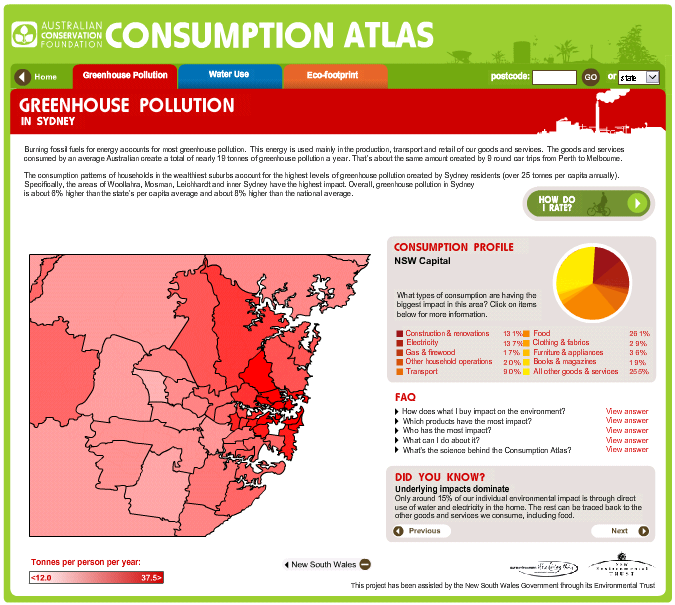 |
Integrated Sustainability Analysis |
 |
| Home Contact Search Media |
Research @ ISAHighlight: The Environmental Atlas of Australia
Consuming Australia � the high price our environment is paying for our spendingISA�s Consumption Atlas, a new interactive online tool developed in collaboration with the Australian Conservation Foundation, reveals that people living in Australia�s wealthiest metropolitan areas are responsible for the country�s highest household greenhouse gas emissions.
�Over-consumption is costing us the earth,� said Chuck Berger, ACF�s Director of Sustainability Strategies. �Use of electricity in the home accounts for just 15 per cent of the greenhouse pollution each of us creates. The majority is created indirectly from the production and transportation of all the things we are buying.� The Consumption Atlas shows households in areas straddling the harbour in inner Sydney acust Queensland are the country�s biggest greenhouse gas emitters. These areas are closely followed by: inner-suburban Canberra; Woollahra and Mosman in Sydney; Southbank and Docklands in Melbourne; and Fortitude Valley and Newstead in Brisbane. The lowest greenhouse gas emitting Australian households are in Tasmania � in the Derwent Valley, Kentish and Brighton areas. �Everything we buy has an impact on the environment, as all things demand energy, water and other natural resources to produce. People can make a difference to their individual contribution to greenhouse pollution by buying less, wasting less and choosing products that last,� Mr Berger said. Food and consumer products, such as clothes, appliances, furniture and electronics often require large amounts of energy, water and materials to produce. �It is better to spend more of our money on services � from sporting-event tickets to massages � because services in general demand fewer resources than goods. There is the bonus that services tend to be more labour intensive or, in other words, more jobs are being created per dollar output.� The Consumption Atlas is based on research by ISA, and was assisted by the ACF through the New South Wales Government's Environmental Trust. The Atlas uses the typical purchasing habits of each suburb in Australia to calculate the impact this consumption is having on the environment, from greenhouse gas emissions to water use and land disturbance. �The households with the biggest environment impact are high-income earning, inner-city, small or single-person households,� said ISA's Chris Dey. �While inner-city households have better access to public transport and are less car-dependent, with their higher incomes they typically buy more things and travel by air more often. But having a high income doesn�t have to have a high impact on the environment; all of us must consume smarter and more sustainably. Expenditure on energy-efficient appliances and cars, on well-designed and insulated houses, and on services rather than goods, can significantly reduce your eco-footprint,� he added. More: choose from the menu to the left |
